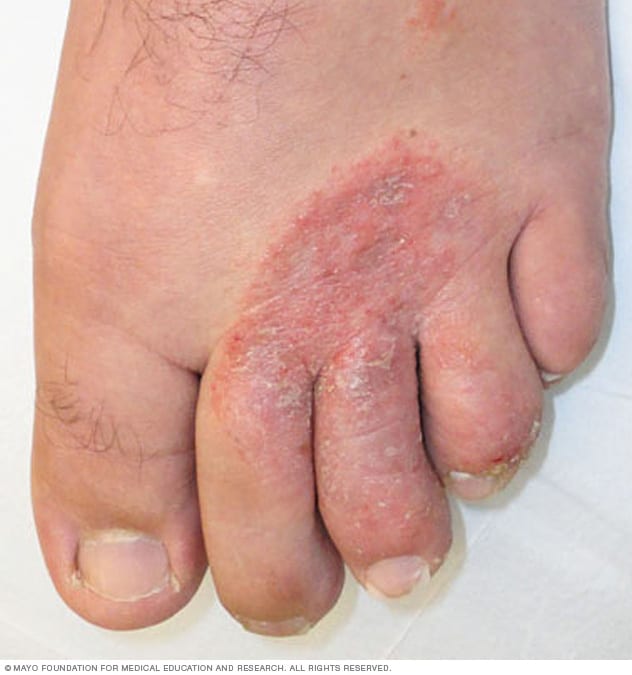-
Athlete's foot
-
Athlete's foot (side of foot)
Athlete's foot (tinea pedis) is a fungal infection that usually begins between the toes. It commonly occurs in people whose feet have become very sweaty while confined within tightfitting shoes.
Signs and symptoms of athlete's foot include a scaly rash that usually causes itching, stinging and burning. Athlete's foot is contagious and can be spread via contaminated floors, towels or clothing.
Athlete's foot is closely related to other fungal infections such as ringworm and jock itch. It can be treated with over-the-counter antifungal medications, but the infection often recurs. Prescription medications also are available.
Symptoms
Athlete's foot usually causes a scaly red rash. The rash typically begins in between the toes. Itching is often the worst right after you take off your shoes and socks.
Some types of athlete's foot feature blisters or ulcers. The moccasin variety of athlete's foot causes chronic dryness and scaling on the soles that extends up the side of the foot. It can be mistaken for eczema or even as dry skin.
The infection can affect one or both feet and can spread to your hand — especially if you scratch or pick at the infected parts of your feet.
When to see a doctor
If you have a rash on your foot that doesn't improve after self-treatment, see your doctor.
If you have diabetes, see your doctor if you suspect you have athlete's foot, especially if you notice any signs of a possible secondary bacterial infection such as excessive redness, swelling, drainage or fever.
Causes
Athlete's foot is caused by the same type of fungus that causes ringworm and jock itch. Damp socks and shoes and warm, humid conditions favor the organisms' growth.
Athlete's foot is contagious and can be spread by contact with an infected person or from contact with contaminated surfaces, such as towels, floors and shoes.
Risk factors
You are at higher risk of athlete's foot if you:
- Are a man
- Frequently wear damp socks or tightfitting shoes
- Share mats, rugs, bed linens, clothes or shoes with someone who has a fungal infection
- Walk barefoot in public areas where the infection can spread, such as locker rooms, saunas, swimming pools, communal baths and showers
Complications
Your athlete's foot infection can spread to other parts of your body, including:
- Your hand. People who scratch or pick at the infected parts of their feet may develop a similar infection in one of their hands.
- Your nails. The fungi associated with athlete's foot can also infect your toenails, a location that tends to be more resistant to treatment.
- Your groin. Jock itch is often caused by the same fungus that results in athlete's foot. It's common for the infection to spread from the feet to the groin as the fungus can travel on your hands or on a towel.
Prevention
These tips can help you avoid athlete's foot or ease the symptoms if infection occurs:
- Keep your feet dry, especially between your toes. Go barefoot to let your feet air out as much as possible when you're home. Dry between your toes after a bath or shower.
- Change socks regularly. If your feet get very sweaty, change your socks twice a day.
- Wear light, well-ventilated shoes. Avoid shoes made of synthetic material, such as vinyl or rubber.
- Alternate pairs of shoes. Don't wear the same pair every day so that you give your shoes time to dry after each use.
- Protect your feet in public places. Wear waterproof sandals or shoes around public pools, showers and lockers rooms.
- Treat your feet. Use powder, preferably antifungal, on your feet daily.
- Don't share shoes. Sharing risks spreading a fungal infection














No comments:
Post a Comment